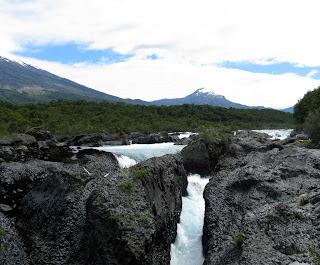











Dear Family and Friends,
It is 2:00 PM and we are hanging out in our stateroom today even though we are in the port of Puerto Chacabuco, Chile, the jumping off point for Coihaique, called the “Capital of Patagonia”, a separate and unique region of Chile. Both Vicki and I are still recovering from our “Adventure in Machu Pichu” and her bronchitis and my head and chest cold. We went out yesterday on an all-day tour up to the Lake District while the ship was anchored at Puerto Montt. It was a wake-up call for us that we needed to slow down a bit. I am sure none of you are surprised by that statement.
The Lake District is the historic homeland of Chile’s indigenous Mapuche people, who revolted against the Spanish colonists in 1598, driving them out of the region. They kept foreigners out of the area for nearly three centuries, slowing the development of the region and keeping it in medieval times. After a treaty ended the last Mapuche war in 1881, Santiago began to recruit waves of German, Austrian and Swiss immigrants to settle the so-called “empty territory” of southern Chile and that off-set the indigenous domination. Today the people are a light-skinned, beautiful race of Spanish speaking citizens with a Bavarian sheen and an old-world charm.
Unlike the part of the Andes we saw while in Peru which were formed by the clashing of Teutonic plates which caused massive upheavals of the earth’s surface, central and southern Chile is volcanic. The geography of the Lake District is characterized by six volcanoes which surround over 50 lakes about an hour’s drive from the coast. Many of the larger lakes are glacial lakes, the largest being Lake Llanquihue. It is the largest lake that is totally within Chile although there is a larger lake that is half in Chile and half in Argentina but the Chilean people don’t like to recognize it. The animosity between these two cultures is rampant and neither one has much of anything good to say about each other.
Lake Llanquihue is 1200 feet deep and very calm. It has an average temperature of 37 degrees although in the summer month (January) it can get up to 55 degrees and that is when all the locals go swimming (burr!). We drove up to a gorgeous area inside the second largest evergreen forest in the world (154 square miles) to Petrohue Falls. It is on Petrohue River that flows from the dominant, snow-capped, 8700 foot tall Osorno Volcano and passes through volcanic rock deposits laden with copper, which gives the crystalline water it’s gorgeous greenish- blue color. After visiting the falls we drove up to the 4000 foot level on “Vulcan Osorno” for a spectacular aerial panorama of the entire Lake District. Hope you like the pictures.
Returning to the ship we visited Puerto Varas, a resort town located on the shores of Lake Llanquihue. The entire town is covered with rose bushes with gorgeous, huge blooms in every color imaginable. I love roses!
The assistant cruise director, Lisa Del Vecchio, who we became friends with back in 2006 on the World Cruise, asked all of the “Survivors of Machu Pichu” to each give her a paragraph about our adventure and 20 photos each for a special slide presentation to be given to all the passengers tomorrow. Another woman and myself wrote a song that the entertainment performers will sing for the crowd…The Machu Pichu Bunch…sung to the Brady Bunch theme music. I will let you know the reaction next Update.
Chile, as I mentioned, was slow to develop into a modern country. Today it is one of the leading exporters of copper, the only industry which is still nationalized and the proceeds go mostly for education. Because of that, aside from sales tax, there are no income taxes in Chile. Education is mandatory through 8th grade but most children go on through high school for four more years. The university used to be free but now it is mostly private and very expensive. The literacy rate is a very high 97 %. Agriculture is still the principal industry with mining second. They import 95 % of their oil and gas from countries like Venezuela, Mexico, Brazil and Columbia, hence their intense investment in alternative fuels and other energy producing sources.
Starting tomorrow we begin three days of cruising the Chilean fjords, with its hundreds of glaciers, snow fields and thousands of icebergs. It is a rugged and gorgeous part of Chile most people may have heard of but few have visited. More on that next time. Until then, God Bless you all.
Jud and Vicki
No comments:
Post a Comment